The army, i.e. ground forces
According to the worst threat scenario, the Soviet Union could mount a surprise attack on southern Finland via the Karelian Isthmus. The major city of Leningrad provided good conditions for establishing and concentrating assault troops near the Finnish border in secret. This threat scenario was behind the decision to release the peacetime army, i.e. ground forces, from the obligation of establishing a field army, i.e. wartime ground forces.
Peacetime Defence Forces
Lieutenant General Hugo Österman, a jaeger officer and the commander of the Finnish Army, led the Finnish Defence Forces in peacetime. The main parts of the Army Command were incorporated into the Ministry of Defence in 1938. The army headed the army corps, the regional mobilisation system, the air force and the navy as well as various military schools and institutions. War planning was carried out by parts of the General Staff that were left outside of the Ministry of Defence in the reorganisation. They were left under the supervision of Field Marshal Mannerheim, who was also the chairman of Finland’s Defence Council. Lieutenant General Lennart Oesch served as chief of the General Staff.
The Finnish Defence Forces
The Border Guard and Coast Guard were under the Ministry of the Interior. The Civil Guard was an independent military organisation that was not part of the Defence Forces. The name Defence Forces was used to refer to the entity comprising the military branches as well as the Border Guard, Coast Guard and Civil Guard organisation.
Peacetime army
The peacetime army was called the army corps, which headed three divisions and the Cavalry Brigade, among other units. Lieutenant General Harald Öhquist, a jaeger officer, was the commander of the army corps. His command headquarters, the Army Corps Headquarters, were located in Vyborg Castle in Viipuri (Vyborg).
The divisions were different from wartime divisions. Supplemented with reservists and Civil Guards, the army corps forces were intended to serve as covering forces in the initial phase of a war. Their mission was to secure the establishment and concentration of the field army, i.e. troops formed mainly of reservists.
The regional mobilisation system established most of the wartime ground forces
The Finnish wartime army comprised the troops who served during peacetime in the 1930s, i.e. the peacetime army, as well as a field army that was established during mobilisation. In addition to the General Headquarters, the field army included three army corps headquarters, nine divisions, four brigades and separate battalions.
Wartime divisions were established by military provinces
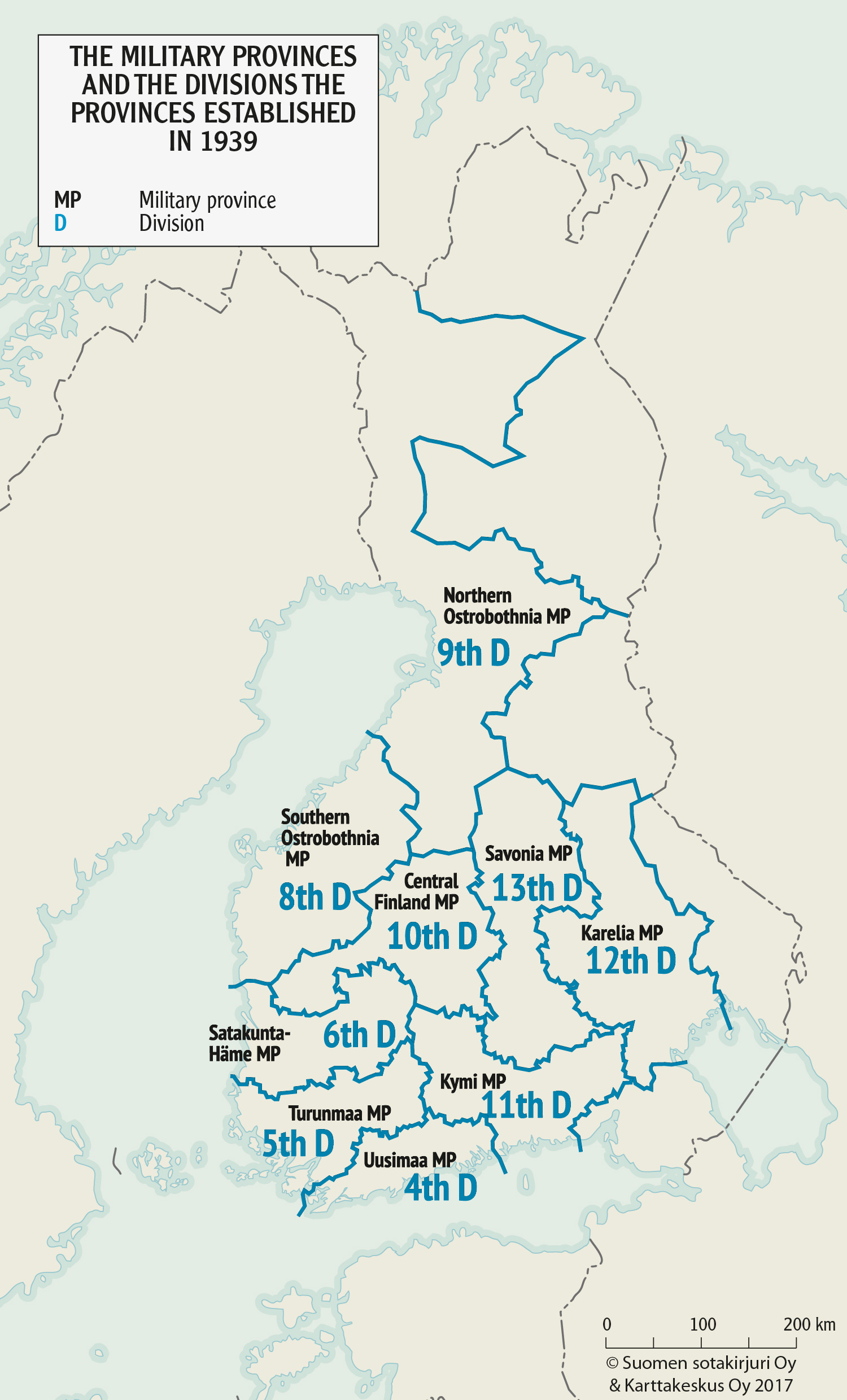 Edited map from the work Raunio, Ari, Sotatoimet – Suomen sotien 1939−45 kulku kartoin (Military Operations – The Course of Finnish Wars in 1939–45 with Maps), 3rd edition, Karttakeskus 2013.
Edited map from the work Raunio, Ari, Sotatoimet – Suomen sotien 1939−45 kulku kartoin (Military Operations – The Course of Finnish Wars in 1939–45 with Maps), 3rd edition, Karttakeskus 2013.
The regional mobilisation system, which was in charge of establishing the field army, was divided into military provinces, which were further divided into military districts. The number of military provinces corresponded to the number of divisions established, i.e. nine. A military province was usually divided into two or three military districts. The latter operated in cooperation with Civil Guard districts. Under these districts were Civil Guard areas and municipal Civil Guard units.
A military province was tasked with establishing the three infantry regiments, one artillery regiment, othercombat and combat support units and logistics troops in its division. A division’s combat support units included field artillery troops and technical troops. The latter included the signal troops and engineer troops. Military provinces could also be tasked with establishing troops for higher command echelons, i.e. the army corps and General Headquarters, as well as naval and air force troops.
The military districts near the border only established covering forces
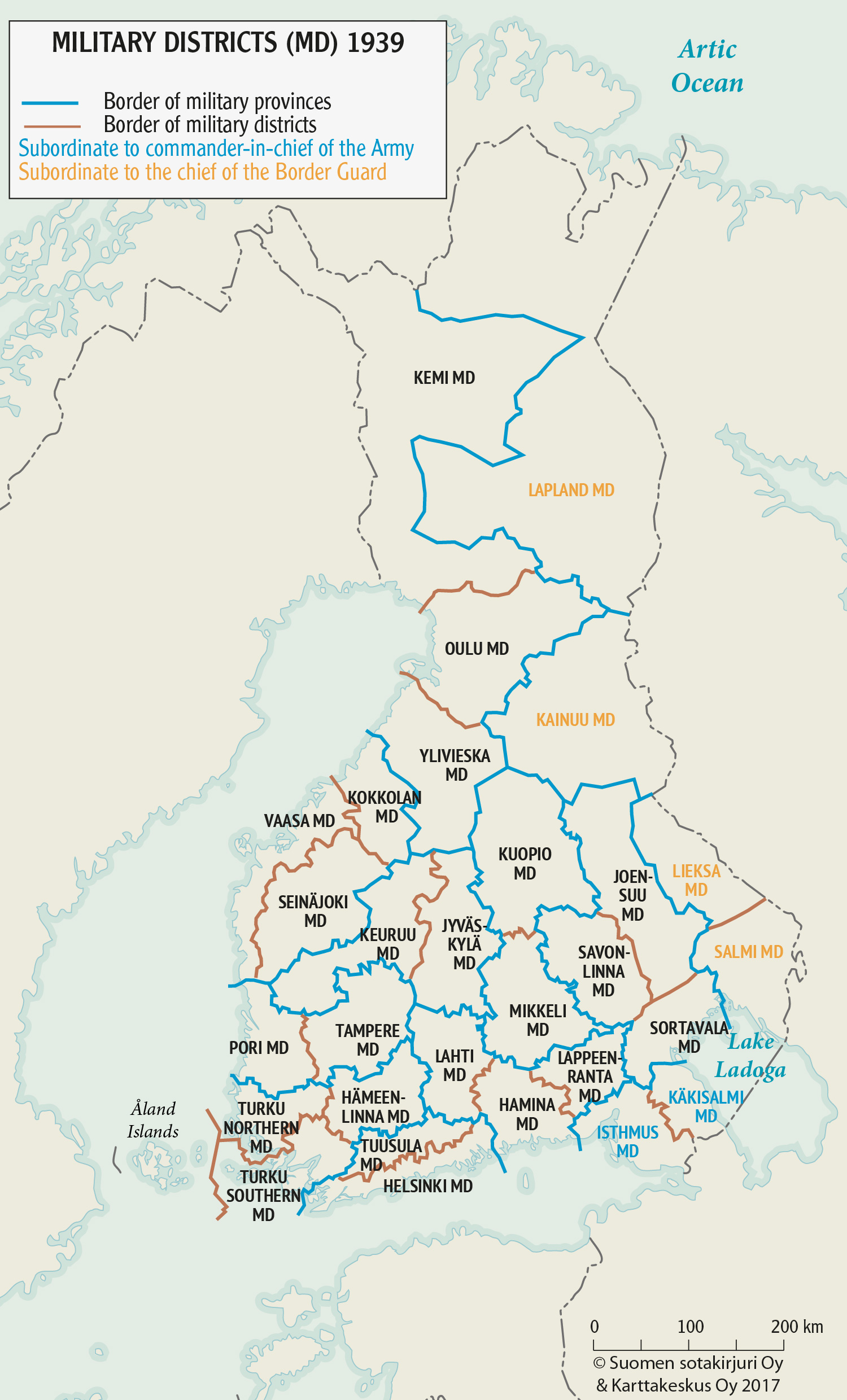 Edited map from the work Raunio, Ari, Sotatoimet – Suomen sotien 1939−45 kulku kartoin (Military Operations – The Course of Finnish Wars in 1939–45 with Maps), 3rd edition, Karttakeskus 2013.
Edited map from the work Raunio, Ari, Sotatoimet – Suomen sotien 1939−45 kulku kartoin (Military Operations – The Course of Finnish Wars in 1939–45 with Maps), 3rd edition, Karttakeskus 2013.
Prior to the Winter War, Finland was divided into 29 military districts. The Åland Islands were left out of this breakdown. Their population was exempt from conscription. Of the military districts, 23 were subordinate to military provinces and thus belonged to their regional organisations. The mission of the six military districts located on the eastern border was to supplement the covering forces formed by peacetime troops.
In these matters, the four Civil Guard districts (LAPLAND CGD, KAINUU CGD, LIEKSA CGD and SALMI CGD) between the Arctic Ocean and Lake Ladoga were subordinate to the chief of the Border Guard, while the two military districts on the Karelian Isthmus (KÄKISALMI MD and ISTHMUS MD) were subordinate to the commander of the army corps.
The wartime role of the chief of the Border Guard was to be in charge of defending the eastern border between the northern part of the Salmi Military District and the Arctic Ocean.
The headquarters, general staff units and logistics units were established in cities
The headquarters, general staff units and logistics units of each division were established in the city where the military province in question was headquartered. The headquarters, general staff units and logistics units of infantry regiments were usually established in the municipality where the military district in question was headquartered. Usually, two Civil Guard areas established a joint battalion or artillery battalion, but large municipal Civil Guard units established their own by themselves.
Infantry and field artillery regiments established by the field army’s regional mobilisation system
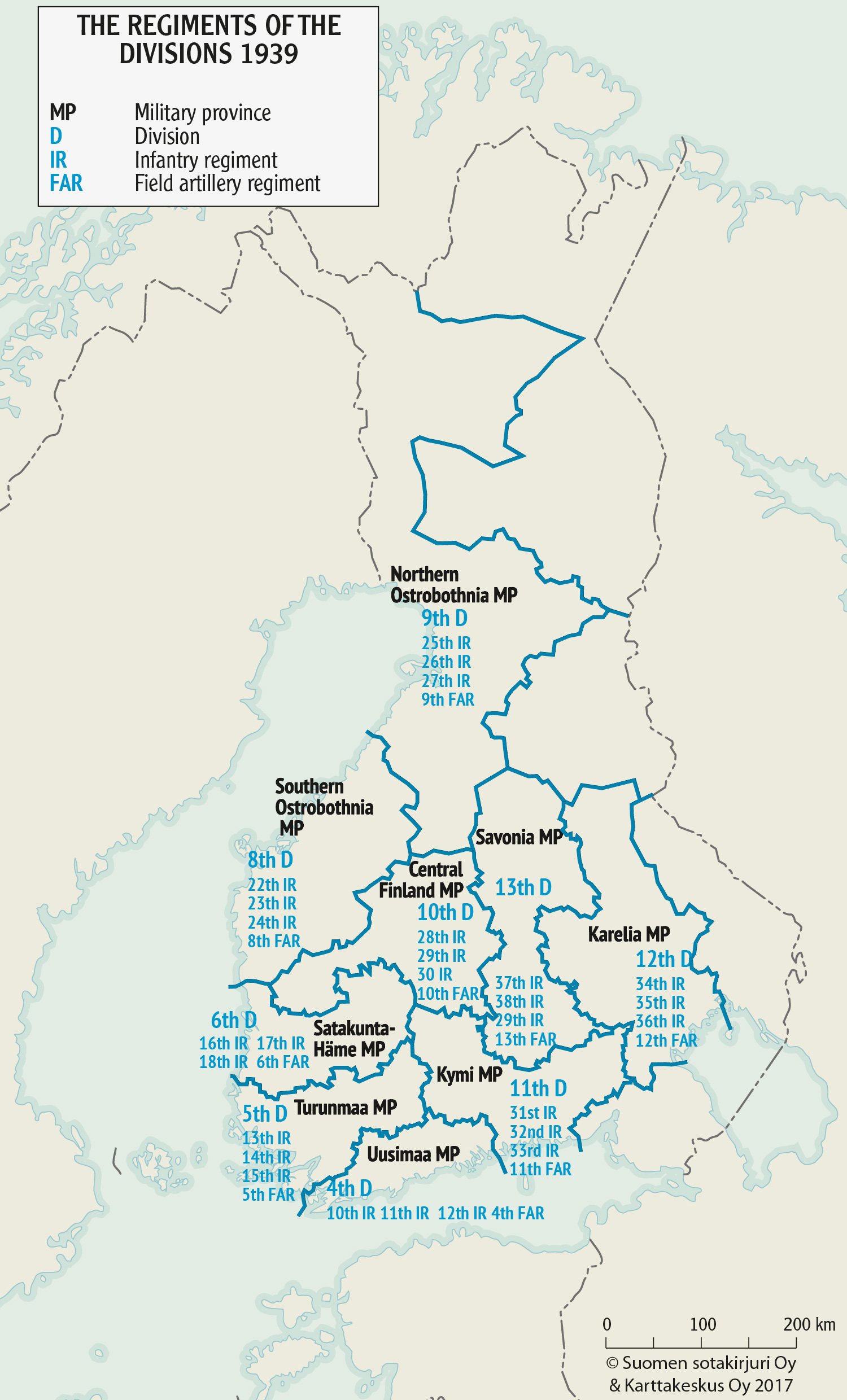 Edited map from the work Raunio, Ari, Sotatoimet – Suomen sotien 1939−45 kulku kartoin (Military Operations – The Course of Finnish Wars in 1939–45 with Maps), 3rd edition, Karttakeskus 2013.
Edited map from the work Raunio, Ari, Sotatoimet – Suomen sotien 1939−45 kulku kartoin (Military Operations – The Course of Finnish Wars in 1939–45 with Maps), 3rd edition, Karttakeskus 2013.
The nine divisions established according to the mobilisation plan included 27 infantry regiments and nine field artillery regiments.
The divisional organisations already had to be changed during the additional refresher training.
One infantry regiment (22nd IR) from the 8th Division was subordinated to the navy for deployment in the Åland Islands. One artillery battalion from the artilleries of the 6th Division and the 9th Division each was subordinated to the navy for deployment in the Åland Islands. The artillery battalion assigned from the 9th Division was the division’s only one, so the division was left without artillery. The division was split into various regiments and assigned to different sections of the front. A new 9th Division was established in Suomussalmi during the war.
At the very start of the war, one infantry regiment (16th IR) from the 6th Division was deployed in the Tolvajärvi (Tolvoyarvi) area, reinforced with one of the division’s artillery battalions. The troops remained in this area throughout the war. In December, the division received the 22nd Infantry Regiment, which had been planned to be deployed to the Åland Islands, from the navy as a replacement for the infantry regiment that had been sent to Tolvajärvi. The 8th Division was left with only two infantry regiments, one of which (23rd IR) it was forced to hand over to the 10th Division in the Taipale (Solovyovo) area during the war.
The numbering of three divisions and their regiments was changed during the Winter War. These were (the numbers in parentheses are those adopted on 1 January 1940):
• Division (3rd D): 16th IR (7th IR), 17th IR (8th IR), 18th IR (9th IR) and 6th FAR (3rd FAR)
• Division (7th D): 27th IR (19th IR), 28th IR (20th IR), 30th IR (21st IR) and 10th FAR (7th FAR)
• Division (2nd D): 31st IR (4th IR), 32nd IR (5th IR), 33rd IR (69th IR) and 11th FAR (2nd FAR).
The peacetime army as covering forces on the Karelian Isthmus
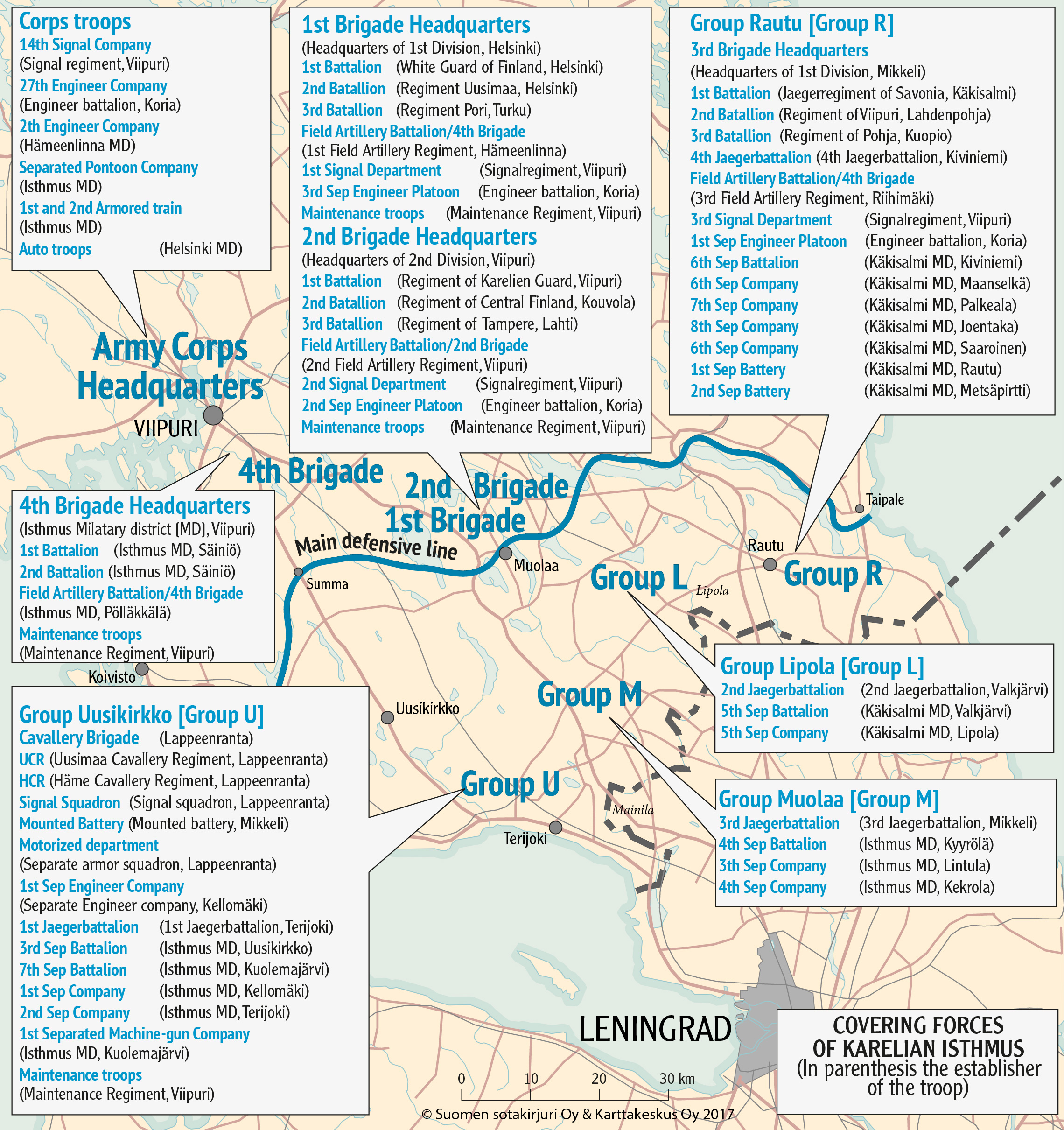 Edited map from the work Raunio, Ari, Sotatoimet – Suomen sotien 1939−45 kulku kartoin (Military Operations – The Course of Finnish Wars in 1939–45 with Maps), 3rd edition, Karttakeskus 2013.
Edited map from the work Raunio, Ari, Sotatoimet – Suomen sotien 1939−45 kulku kartoin (Military Operations – The Course of Finnish Wars in 1939–45 with Maps), 3rd edition, Karttakeskus 2013.
As the threat of a surprise attack was considered to be greatest on the Karelian Isthmus, the plan was to deploy the troops of the peacetime army corps there practically in their entirety.
The peacetime brigade-level units had to form four brigades and the Cavalry Brigade, among other units, out of recruited personnel, conscripts in active service as well as reservists and Civil Guards who were called to service. The headquarters of each peacetime division had to be turned into army corps headquarters. Two of them operated on the Karelian Isthmus and one in Ladoga Karelia, north of Lake Ladoga.
Covering forces between Lake Ladoga and Ilomantsi
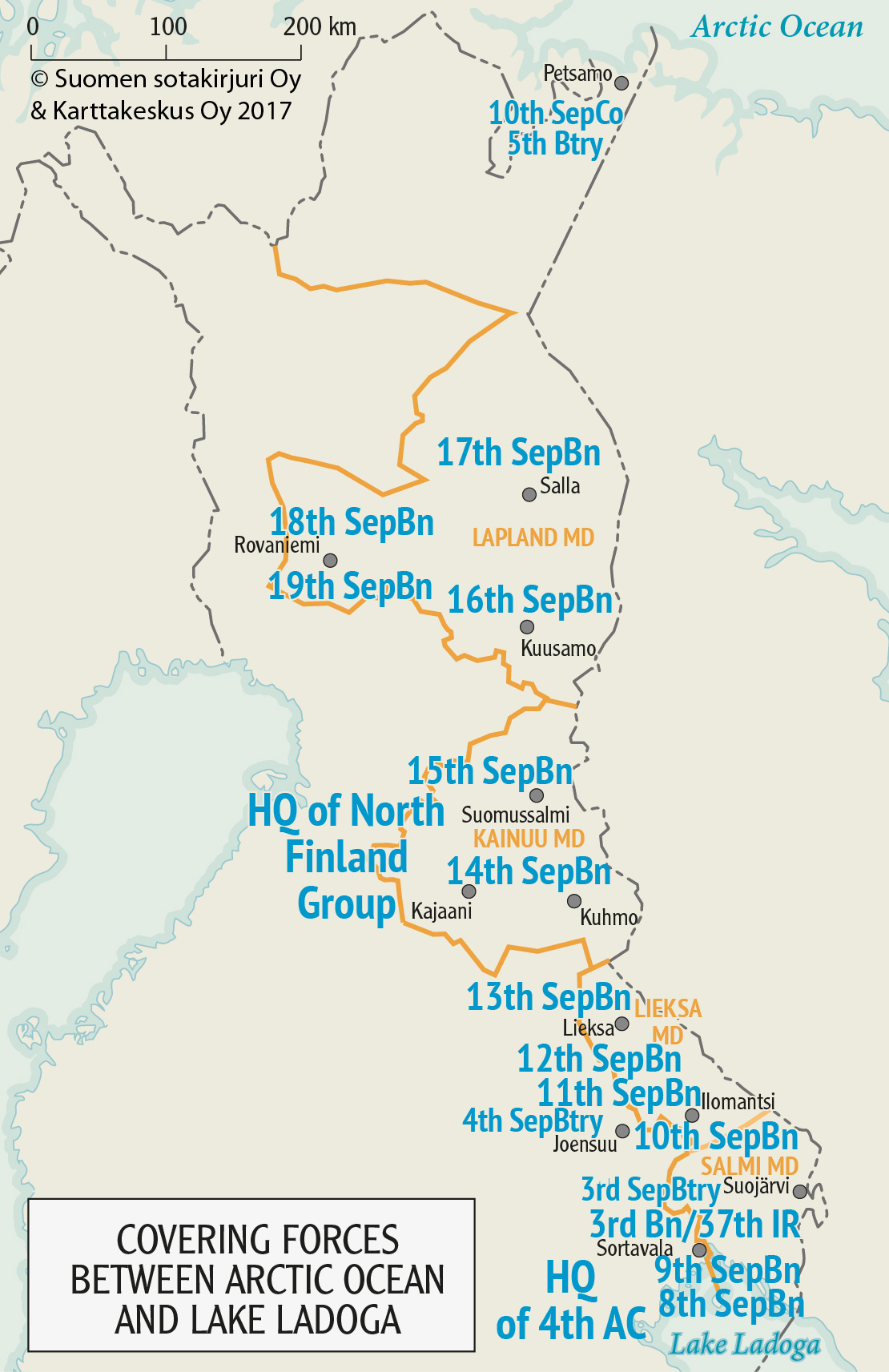 Edited map from the work Raunio, Ari, Sotatoimet – Suomen sotien 1939−45 kulku kartoin (Military Operations – The Course of Finnish Wars in 1939–45 with Maps), 3rd edition, Karttakeskus 2013.
Edited map from the work Raunio, Ari, Sotatoimet – Suomen sotien 1939−45 kulku kartoin (Military Operations – The Course of Finnish Wars in 1939–45 with Maps), 3rd edition, Karttakeskus 2013.
The Salmi Military District (SALMI MD) and Joensuu Military District established the covering forces for the area between Lake Ladoga and Ilomantsi. These corps included three separate battalions (8th SepBn, 9th SepBn and 10th SepBn) and one battalion from the 37th Infantry Regiment (III/37th IR). The only covering forces unit in the area that was established by the peacetime army was the 4th Corps Headquarters. It was established by the peacetime 3rd Division Headquarters that operated in Mikkeli.
Separate battalions were established at training centres
The Border Guard Headquarters established the North Finland Group Headquarters, which belonged to the covering forces. In the group’s territory, which spanned from Ilomantsi to Petsamo,
the covering forces and planned wartime troops comprised eight separate battalions, one separate company (10th SepCo) and two separate batteries (4th SepBtry and 5th SepBtry) established by the Border Guard districts and military districts in the border region (LIEKSA MD, KAINUU MD and LAPLAND MD). The separate battalions were: 11th SepBn, 12th SepBn, 13th SepBn, 14th SepBn, 15th SepBn, 16th SepBn, 17th SepBn, 18th SepBn and.
In municipalities near the border, troops were established at training centres. So many additional personnel had often been called to service at these centres that it was also possible to form an additional unit, usually a separate company.
Field army deployment plan
The majority of the field armys nine divisions, i.e. five divisions, was planned to be concentrated on the Karelian Isthmus, with another two divisions concentrated in the area north of Lake Ladoga, between Ladoga and Suojärvi (Suoyarvi). Separate battalions formed of the Border Guard’s own peacetime troops and reservists were reserved for defending the area between Ilomantsi and the Arctic Ocean. Including all Border Guard battalions, the reservists were roughly equal in number to a division’s infantry. The plan was for these troops to defend a front of over 1,200 kilometres in length without artillery.
Of the field army’s nine divisions, two were planned to be used as the commander-in-chief’s reserves. One was planned to be concentrated in the Taavetti area, at the rear of the Karelian Isthmus, while leaving the other at its place of establishment in the Kemi–Oulu region. The latter division lacked artillery, among other things.
Ari Raunio

 SUOMEKSI
SUOMEKSI PÅ SVENSKA
PÅ SVENSKA по-русски
по-русски